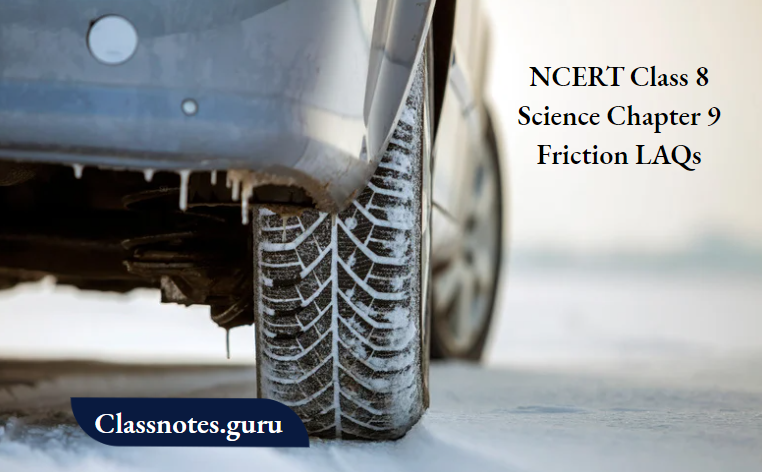NCERT Class 8 Science Chapter 7 Reaching The Age Of Adolescence LAQs
Question 1. A few days back, Shradhaa, a student of class Vth, was driving a car. She went to a crop field. The road level was just above the level of the ploughed field. As she wanted to stop the slow-moving car, the brakes failed to work. Suddenly, she turned the car towards the ploughed field. After some time, the car came to rest.
1. Shradha turned the car towards the ploughed field. Explain why?
Answer:
She turned her car towards the ploughed field to protect herself from an accident.

NCERT Solutions for Friction LAQs Class 8
2. Explain how the car came to rest after covering some distance in the ploughed field.
Answer:
The car moved from the road to the ploughed field, so the force of friction between the tyre and the ground surface suddenly increased. Because the large number of irregularities reduces the movement of the tyre. Thus, the car came to a rest.
3. Mention the values that Shradha exhibits here.
Answer: The values displayed by Shradha are intelligence and awareness.
![]()
Question 2. In a Physics classroom, a teacher told to his students that when a cricket player wants to catch a ball then he first rubs his hands. Thus, there is less chance of slipping the ball from the hands.
1. Explain the reason for not slipping of ball from the hand.
Answer:
The player rubs his hand, due to which the palms become warm which absorbing the moisture from the surface and making the surface rough. So, due to the roughness of the hands, the ball may get a better grip between the hands and will not slip.
NCERT Solutions for Class 8 Science Friction LAQs
2. If the player makes his hands oily instead of rubbing them, would he be able to catch the ball?
Answer:
The player makes the palm surface oily. The number of irregularities decreases, and the surface becomes smooth. So, the ball slips off easily from the hand.
3. Mention the type of teaching skills of the teacher that is being represented here.
Answer:
As, teacher wants to teach the students through easy examples. So, this act of teaching shows the experience and ideality of the teacher.
Question 3. Explain with the help of an example that heat is produced by friction.
Answer:
As friction opposes the relative motion between the two surfaces, it produces heat. So, when we rub our hands together vigorously for a few minutes, we feel heat. Similarly, when we strike a matchstick against the rough surface, it catches fire.
NCERT Solutions for Friction Chapter 9 LAQs
Question 4. We have two identical metal sheets. One of them is Tube 3 Tube 4 rubbed with sandpaper, and the other with ordinary paper. The one rubbed with sandpaper shines more than the other. Give a reason.
Answer:
While rubbing with sandpaper, more frictional force is produced between the layers of the metal sheet and sandpaper, which causes more force on the dust particles, and they are removed easily, so it will shine more. But in the case of ordinary paper, the force of friction is not sufficient to remove all the dust, so it will shine less in this case.
Question 5. Friction is In force that acts betweenn two surfaces that slide across one another. It is net in the opposite direction in which the object is moving. Friction is the cause of it both in and out. It prevents our shoes from slipping on the footpath when we walk, but sometimes it may also harm us. It reduces the efficiency of a machine. There isn’t a lot of energy loss due to friction. Friction enn bo produced by some methods. For example, we use lubricants like oil, grease to reduce the friction between the moving parts of n machine. In many machines, friction is reduced by using ball bearings.
1. Which of the following can be used as a lubricant?
- Mustard oil
- Soil
- Paper
- Iron powder
Answer: 1. Mustard oil
2. Friction always acts in which direction that to the moving body.
- Perpendicular
- Same direction
- Opposite direction
- Always downward
Answer: 3. Opposite direction
NCERT Class 8 Science Chapter 9 Friction LAQs
3. Friction can be increased by using
- Lubricant
- Chalk powder
- Oil
- Talcum powder
Answer: 2. Chalk powder
